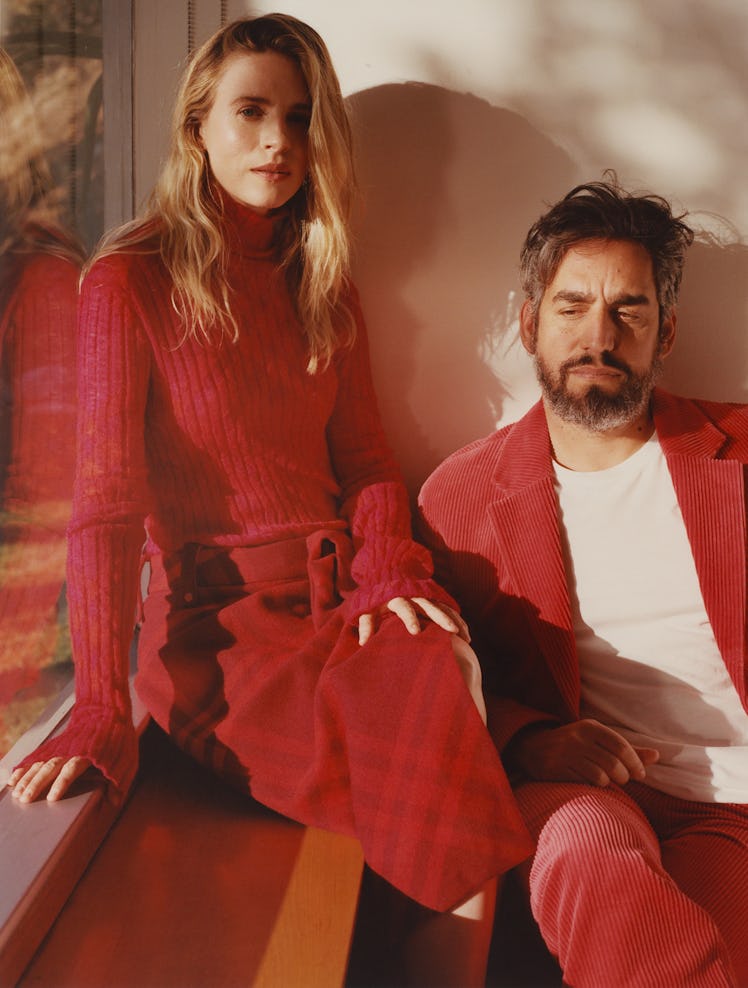
For W’s annual The Originals portfolio, we asked creatives—pioneers in the fields of art, music, food, dance, fashion, and more—to share their insights on staying true to themselves. See this year’s full class of creatives here.
In your latest collaboration, the FX series A Murder at the End of the World, out November 14, an eccentric billionaire, played by Clive Owen, summons an eclectic group of strangers to his exclusive enclave in Iceland, where one of them winds up dead. Emma Corrin plays Darby Hart, a writer who investigates that death. Like your series The OA, A Murder at the End of the World combines technology, otherworldliness, and intrigue in a story that takes place in the not-too-distant future. But let’s go backward: How did you two meet?
Zal Batmanglij: I met Brit when we were both at Georgetown University. This was a few decades ago, and the school was having their first-ever film festival. My friend Mike and I had made two short films, and Brit, who was 18 and a freshman, led the standing ovation for our movies. I thought, Who is this magical girl? She was so blonde, like Cosette in Les Misérables coming to life.
Brit Marling: Their film was called Lucid Gray, and it was beautiful. I was an economics and art double major, specializing in photography. I started following Zal and Mike around campus. Finally, I saw Zal at the supermarket and introduced myself.
ZB: I said, “Maybe you could be in the next film we make?” She was like a sunbeam, and I wanted to capture that. But Brit had a better idea, which was to collaborate. Eventually, it was her mind that blew me away—and changed my life.
BM: At Georgetown, there was a certain idea of what you were supposed to become. My plan was to be recruited by the CIA [Laughs], but when Zal and I started working together, I saw that being a spy would not be as fun or interesting.
ZB: We became aware, as we got older, that queer folks and women make great creative partnerships. Look at Patti Smith and Robert Mapplethorpe, Nan Goldin and David Armstrong. Queer people and women—we inspire each other!
Miu Miu cardigan and top.
How do you begin a project like A Murder at the End of the World?
BM: We like to have a dreamy phase.
ZB: We feel like we have a garden, and we plant lots of ideas and see what takes root. Brit said something that stayed with me: “At any time, there are 40,000 unidentified dead in the United States, and half of those are women.” Essentially, America is a graveyard of unnamed women. That hit me like a cannonball.
BM: I have always been intrigued by amateur sleuths. And I’m fascinated by these big, fancy tech retreats, which are the seats of power in the world today. In an Agatha Christie mystery, the murders would take place at a country mansion. We wanted to set our murder against the backdrop of people who are invested in the future.
One of the features of the show is how prescient you were about AI, which you call “alternative intelligence.”
ZB: We did so much research into this world. In fact, many people in this space have been calling it “alternative intelligence” rather than artificial intelligence for a few years now. We didn’t want to scare people with the science, but we did want to explore the inherent problems and benefits of technology.
In the beginning of your career, did people understand your partnership?
BM: There was a lot of pressure. People love the story of a solitary rise to genius. But if you look into any success story, collaborators are always deeply influential. People try to pull you apart, but I wouldn’t be the same without Zal whispering in my ear, “That was the best take.”
Bode pants; Gucci shoes; his own jacket, T-shirt, cap, and watch.
Who do you think is an original?
BM: Hayao Miyazaki. When I watch a Miyazaki film, I feel the originality in all of his ideas. Take Princess Mononoke—there are these characters with rattling heads. They are so evocative, so true to something pure. How did he come up with them? His ideas seem to spring from the ether.
ZB: Adam Curtis is an original. He is a BBC archivist who makes documentaries. He makes fascinating connections between ideas.
What happens when you two disagree?
ZB: If you believe that the story is the queen—which we do—then the best thing for the story is clearly the best thing. And Brit will put her foot down. That’s very rare, but when it happens, I know I should listen. Brit is always right.
BM: Always! [Laughs]
Hair by Laini Reeves for LOLAVIE at ASM Inc.; makeup by Sarah Uslan for Clé de Peau Beauté at the Visionaries; photo assistants: Bailey Beckstead, Essence Moseley; fashion assistant: Cassidy Mamula.
This article was originally published on